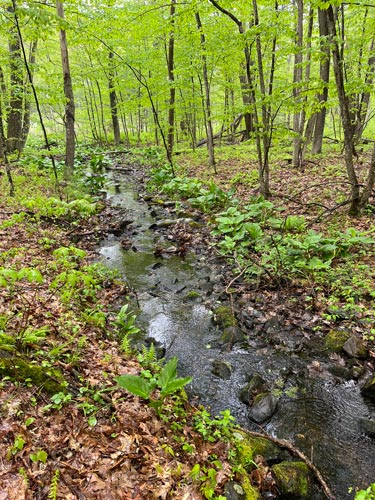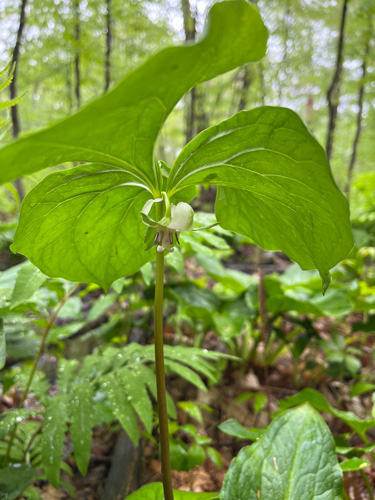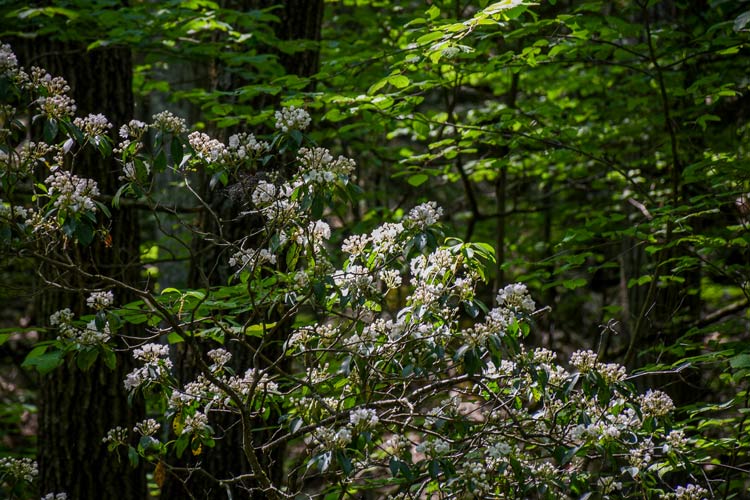By Mark Richardson, Director of Horticulture at New England Botanic Garden
January 2024

Small brook where crayfish were found
I joined the staff at New England Botanic Garden in 2018. At that time, we had recently acquired about 20 acres of land to the north of the Inner Park from the Kim family. That parcel, a piece of undeveloped land featuring mixed oak forest, brought the Garden’s total footprint up to about 171 acres and meant more protected open space for the town, the Garden’s 200,000+ annual visitors, and, importantly, the Wachusett Reservoir.
While settling into the position as director of horticulture, I wanted to be sure I understood the property boundary and the wild plants growing around the edges of the Garden. I spent a lot of time exploring the natural areas in my first six months on the job, discovering beautiful natural features—from springs to rocky slopes, old forgotten stone walls, and a beaver dam that flooded several acres of land on the east edge of the property. I also discovered a beautiful little waterfall, a small brook with crayfish and false hellebore (Veratrum viride), a large, sunny open wetland, a giant stand of mountain laurel (Kalmia latifolia), and some nodding trillium (Trillium cernuum)—all this on an adjacent parcel of land with dubious ownership records.
In small towns like Boylston, folks occasionally lose track of land ownership. This was indeed the case with the land I stumbled onto—a 14 acre lot known as parcel 48-3. The town assessor’s maps indicate that it once was owned by someone named Joslin, but the assessor had no knowledge of who currently owned the property, or where to send the property tax bill. As a result, the parcel was sitting as a liability on the town’s books. Perhaps this was an opportunity to remove this liability from the town and expand the Garden’s property once again. But where to begin?
A friend of mine had started volunteering at the Garden shortly after I joined the staff. Leslie Duthie was about to retire after more than 30 years working as horticulturist for Norcross Wildlife Sanctuary. In addition to her extensive native plant knowledge, Leslie is a strong advocate for land preservation who volunteered on the board of Opacum Land Trust in her hometown of Monson, Massachusetts. When I brought Leslie out on a walk around the wilder edges of the property, she saw what I saw in this forgotten parcel of land—beautiful natural features with a dense understory of native plants that could make a wonderful addition to the Garden’s visitor experience. She also saw an opportunity to conserve land that might otherwise be developed if the town decided to pursue a sale. Fortunately, she knew plenty about land records and land conservation and encouraged the Garden’s leadership to pursue acquisition of the property. Leslie was instrumental both in navigating the land acquisition process, which took nearly two years to complete, and in funding the effort.

Nodding trillium (Trillium cernuum), native to the Northern parts of the U.S. and Canada
Acquisition of the Joslin Lot was recently finalized, so now we can start to think about opening the property for Garden visitors to enjoy. In the coming years, we’ll explore the property further to better understand all the site has to offer. While we’ll never build anything on this land (a conservation restriction prevents anyone else from developing it, too), we plan to install low-impact trails to allow visitors to experience the site and to highlight the native plants that naturally occur here, plants that many people don’t have an opportunity to see because continued development and habitat loss makes them scarce.
Land conservation is one of the single most important actions we can take to support biological diversity and protect natural resources. From providing habitat for native species to protecting drinking water and sequestering carbon, land conservation offers myriad benefits to people and the natural world we all enjoy. Plus, would a visit to New England Botanic Garden at Tower Hill be as great without the protected land that surrounds the core of the Garden?
I’m proud that one of our Garden’s core values is environmental stewardship. It guides so many of our land management decisions and drives us to do as much as we can to preserve our vital natural resources in pursuing our mission.
About the Author
Mark Richardson was Director of Horticulture at New England Botanic Garden from 2018 to 2024. He currently serves as Director of Strategic Horticulture Partnerships. In this capacity, he works as executive director of two leading environmental organizations that entered into formal affiliation with the Garden in 2024, the U.S. branch of Botanic Gardens Conservation International (BGCI-US) and the Ecological Landscape Alliance (ELA).

